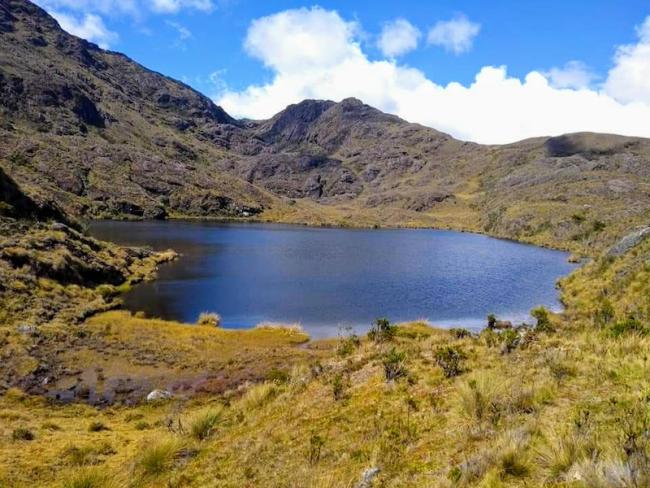
“Do you see the mountain over there? That mountain is going to disappear. One day, a machine will come and eat the mountain.” Mayerly López, an activist with the collective Comité Santurban, recounted the words of late artisanal mining activist Mariluz Lizcano, who stirred López into lifelong environmental activism. Lizcano was referring to the Canadian mining company Eco Oro, which was preparing to dig into the Santurbán páramo (moorland) in 2009 to develop the Angostura gold and silver mine. López was still in high school when she confronted the question: what will happen to the mountain?
Today, the mining project Soto Norte, owned by the Canadian company Aris, is stirring up another hornet’s nest amid urgent calls for the conservation of Colombia’s biodiversity, social rifts, and claims that criminal organizations are infiltrating the páramo. Many have long opposed Soto Norte for the same environmental impacts that halted the Angostura mine back when López was first exposed to the potential impacts of industrial mining in the Santurban mountains. Opponents want to prevent the type of retaliation that Eco Oro unleashed almost a decade ago when the company sued Colombia for protecting the páramo. They also see Aris’ collaboration with an artisanal mining company as co-opting local industry.
Contaminating the Páramo
Eco Oro began exploration in 1994, then known as Greystar. The Colombian government denied the Angostura mine an environmental license twice in 2009 and 2011, citing risks of water contamination in one of Colombia’s most important ecosystems. In response to a mining ban in the páramo, Eco Oro sued Colombia in 2016 under the Canada-Colombia Free Trade Agreement.
High in the eastern Colombian Andes, the ancient and rainy Santurban páramo spans more than 142,000 hectares and is home to many endangered species and alpine plants critical to healthy watersheds. Additionally, the páramo’s watershed supplies drinking water for over 1.3 million people in Colombia’s Bucaramanga metropolitan region alone. Intended to launch in 2029, Soto Norte is one of South America’s largest feasibility-stage copper and gold mines and is expected to produce about 8.5 million ounces (500,000 pounds) of gold annually. The $1.2 billion mine changed ownership in June 2023 from the United Arab Emirates’s Minesa to Vancouver-based company, Aris Mining.
A filtered tailings dam proposed near the Suratá municipality of Santander poses significant risks to the environment and nearby communities. Dam materials could seep acidic and heavy metal pollution into the watershed. According to Steven Emerman, a retired hydrology professor at Utah Valley University, the dam design far exceeds the current technological capacity for storing large quantities of filtered tailings in the rainy Andean locale. The catastrophic collapse of a dam in Brumadinho, Brazil, which killed over 250 people and decimated nearby municipalities, should certainly be a deterrent for building too big and too close to residential buildings.
Soto Norte’s tailings dam would be just a mile from the Suratá town hall and even closer to the nearest houses, according to Emerman. “It’s quite alarming,” he said. “The tailings facility would be on a very steep slope. If you had a failure of the facility, that flood of tailings would arrive in Suratá quite quickly.”
In 2019, around 50,000 people protested in Bucaramanga against Soto Norte. The following year, Colombia’s National Authority of Environmental Licensing found Minesa’s feasibility reports insufficient and shelved their environmental license. Since taking over Soto Norte, Aris has been redeveloping a “scaled-down mining concept,” backtracking Minesa’s claim that the site couldn’t be made smaller. The update is expected this year, with Aris stating that Soto Norte remains outside the delimited páramo conservation area. Santander’s Environment Minister, Miguel Ángel Castañeda Acosta, said the department is committed to protecting water and biodiversity, citing Governor Díaz’s recent support for a pause on mining in the páramos. Soto Norte has not yet been granted an environmental license, and the Environment Ministry is not aware of any proceedings currently underway, despite Aris’ plans to move forward.
Securitization of the Páramo
Amid growing tensions between industrial mining and opposition, however, the páramo’s conservation is becoming less of an environmental issue and more of a politicized security campaign where the threat of Colombian criminal organizations justifies increased militarization. A proposed national conservation effort has further exacerbated social divisions.
In November 2024, Colombia’s former Environment Minister Susana Muhamad proposed a Temporary Reserve Zone (TRZ) that would prohibit industrial mining in the páramo for two years and halt Soto Norte. With the Environment Minister’s resignation on February 9, the zone’s future remains uncertain. California mayor Danilo Valbuena, artisanal miners working with Soto Norte, and Suratá mayor Ecxon Pabón have criticized Soto Norte’s arrested development as an obstacle to formalization that legalizes artisanal miners, and a condemnation of their communities to poverty.
Aris is contracting Calimineros, a company representing over 160 families and affiliates from the California municipality. Established in 2018, Calimineros claims to be the first in Colombia to formalize artisanal miners via the Organization for Economic Co-operation and Development (OECD).
“All the institutional actors—in this case the Governor, local governments, and other local mining actors—have a contractual relationship or a political relationship with Aris Mining,” Juan Camilo Sarmiento Lobo, professor of law and political science at the Industrial University of Santander, said.
The Governor of Santander, Juvenal Díaz Mateus, stated in May 2024 that the Gulf Clan (Gaitanistas) cartel is one of the criminal groups expanding into the páramo and denounced its influence on artisanal miners, saying “these groups start taking over the mines and create deaths and displacements.” As a former military general, Díaz called for increased militarization in the páramo.
Cartel activity in the páramo has not been confirmed by the Ombudsman’s Office of Colombia (Defensoría del Pueblo)’s alert system or by the Secretary of Interior in Santander. Tiziano Breda, an analyst with Armed Conflict Location and Event Data, confirmed that the Gulf Clan’s activity is concentrated around Barrancabermeja and Puerto Wilchés. Here, the cartel supports its activities in neighboring departments through extortion and drug trafficking within Santander’s oil industry. Conflicting reports refer to a criminal group in the páramo loosely known as “Los Paisas,” but their affiliation with the cartel is unconfirmed.
“We are very concerned with a deepening strategy of stigmatization and criminalization,” Lobo added, seeing Díaz as effectively positioning Aris as a solution to illegal artisanal mining in the region. Aris has claimed that Soto Norte is “a pragmatic solution to reduce existing harm caused by informal mining activities and supports development of the local communities.”
By working with an artisanal mining company, Soto Norte gives the appearance of supporting local miners through regulated industry and contributing to regional stability. But when environmental activists are already targeted in smear campaigns, this could further marginalize opposition.
Human Rights Under Fire
In the face of the environmental and securitization debates surrounding the páramo, Comité Santurban, who oppose the renewed encroachment of industrial gold mining, continue to organize against the gold mine. On October 18, they led another protest of over 20,000 people defending the páramo watershed and denouncing Soto Norte and Aris’ co-optation of small-scale mining. Activists quickly became a target.
The Comité Resistencia Soto Norte, a local organization supporting collaboration with Aris and Calimineros, published a digital pamphlet in December 2024. The Comité Resistencia declared Soto Norte’s El Tanque and El Mortiño sites closed to non-Santander residents. They claim the TRZ violates the Escazú Agreement because local communities were not consulted. According to López, this argument is simply a co-optation of environmental mechanisms by mining interests. The Comité Resistencia has also declared four members of the Comité Santurban to be “personae non grata”: activist Danovis Ferley, Green Alliance politician Fabián Díaz, lawyer Hernán Morantes, and Mayerly López.
“There’s a lot of fear talking about these issues. Santander is very similar to Antioquia. These are very conservative departments,” Viviana Herrera of the Canadian non-profit Mining Watch, said, referring to Santander’s neighboring department where Aris developed its Segovia gold mine. Long impacted by the presence of right-wing paramilitaries, Antioquia was formerly governed by right-wing politician Álvaro Uribe, who eventually became Colombia’s president and oversaw some of the country’s most brutal years of corruption, paramilitary violence, and human rights abuses.
Resisting big capital and development projects in these regions earns you the label of guérillero, Herrera explained, referring to the stigmatization of activists as members of armed groups. In 2018, Movimiento Ríos Vivos activists who opposed hydroelectric development in Antioquia were designated military targets by the Gulf Clan. “In a department with a history of being right-wing, being an environmental defender is like putting a death threat on your head,” Herrera added.
Activists are wary of Canadian retaliation against a possible industrial mining moratorium in the páramo. While Aris has not indicated any aggressive response, Eco Oro sued Colombia after the government banned oil, gas, and mining operations in the páramo in 2016. Will Soto Norte be another ruthless notch in the legacy of the Investor-State Dispute Settlement (ISDS) claims that Canadian companies have historically launched, suing Colombia for damages to foreign investment?
The Comité Santurbán are undeterred. On February 10, they led another protest, this time in Bogotá, supporting the páramo’s Temporary Reserve Zone. “Our gold is water,” demonstrators declared, calling for sanctions against Aris and Minesa and “full reparations” for pollution. They called on the Canadian embassy in Bogotá to act on the Voices at Risk guidelines for diplomats to support threatened human rights defenders, including members of the Comité Santurban. They are also calling for the elimination of ISDS clauses under the Canada-Colombia Free Trade Agreement that have undermined environmental protections and the withdrawal of Colombia from the International Centre for Settlement of Investment Disputes Convention, a treaty that governs legal dispute and resolution of ISDS cases.
“People on the ground feel the impacts of these trade agreements,” said Herrera. “They are the ones who have to bear the consequences of allowing companies to operate and come to other countries, such as Colombia, with zero accountability—and with all the protections in order to operate.”
Lital Khaikin is a freelance journalist based in Montréal.

